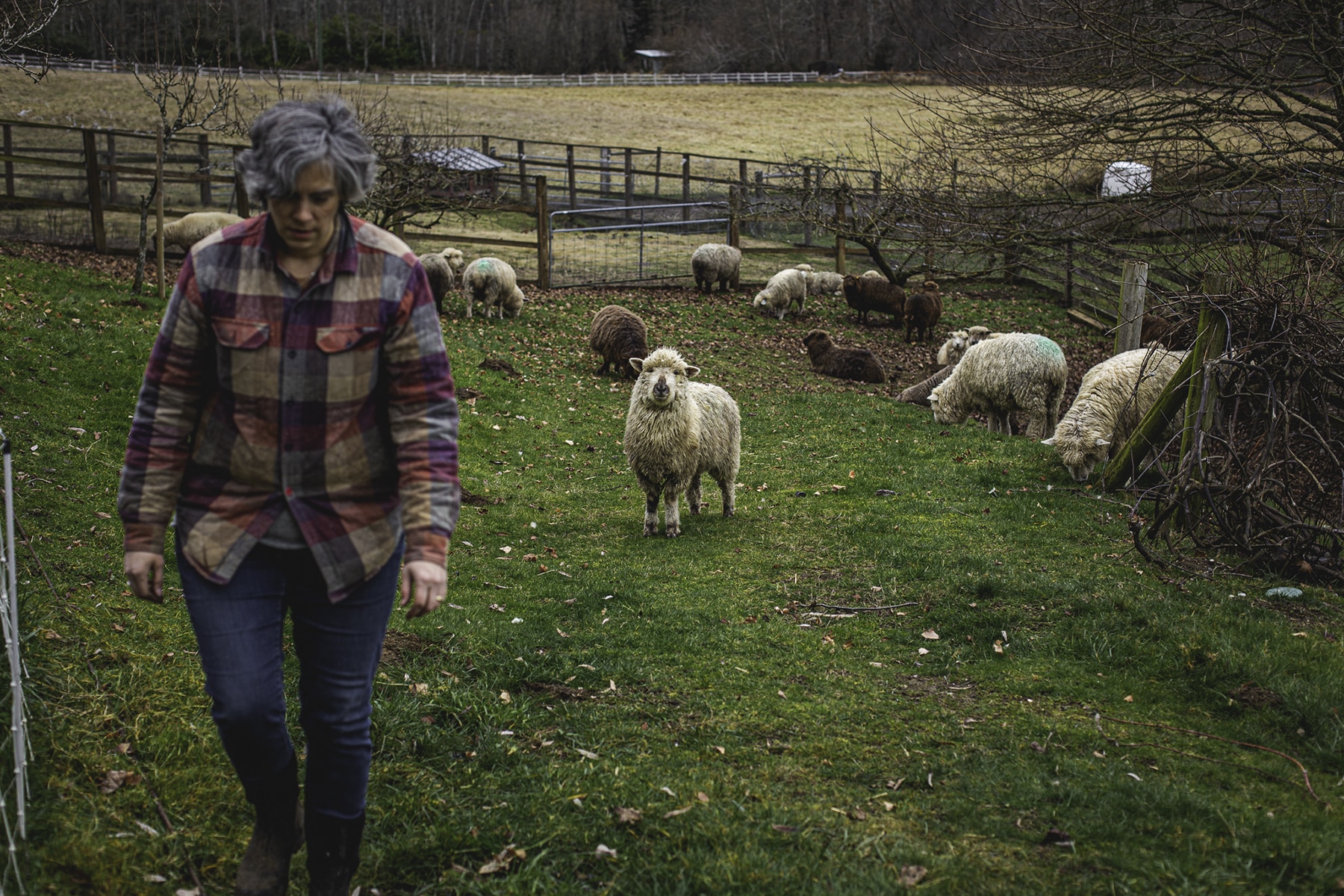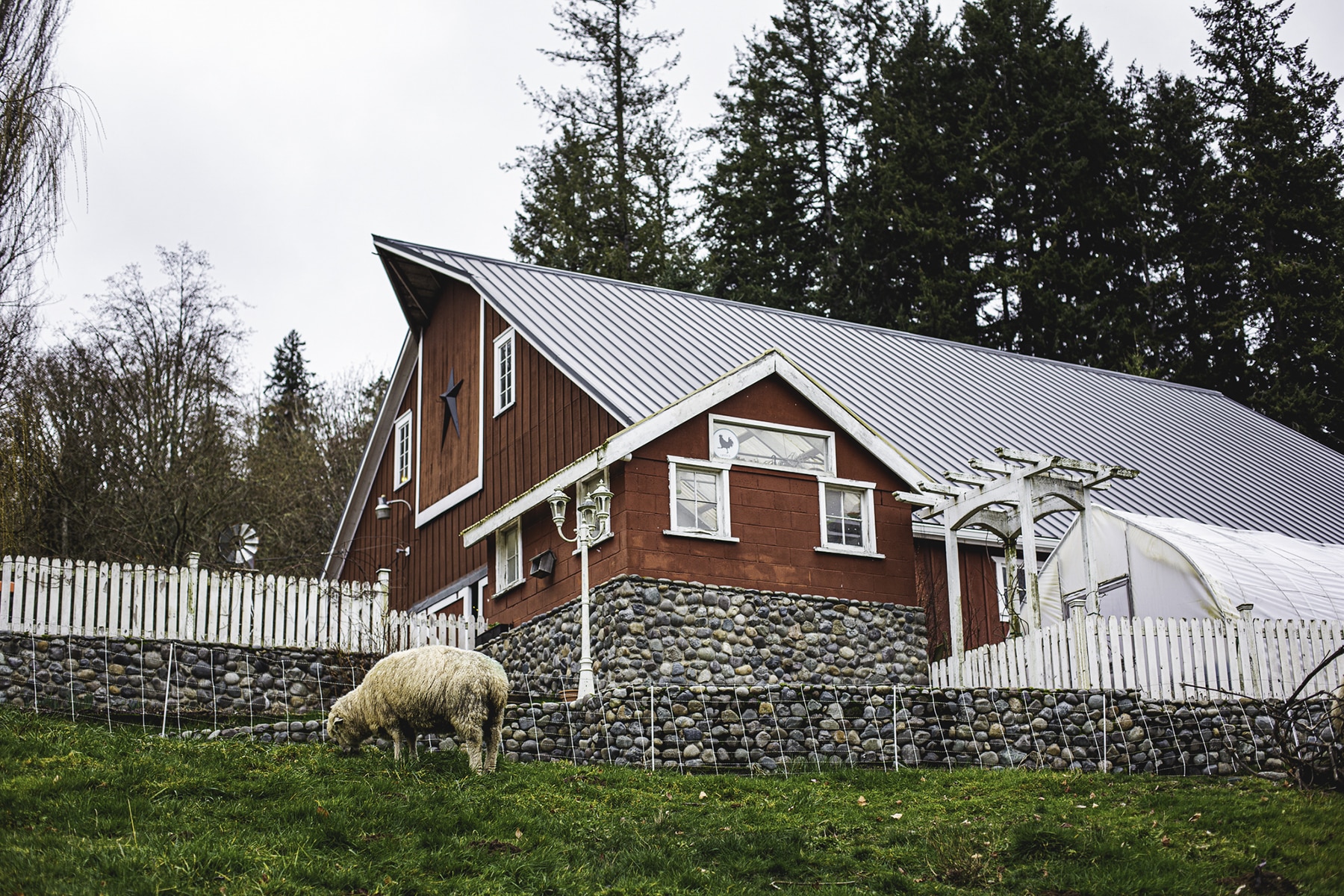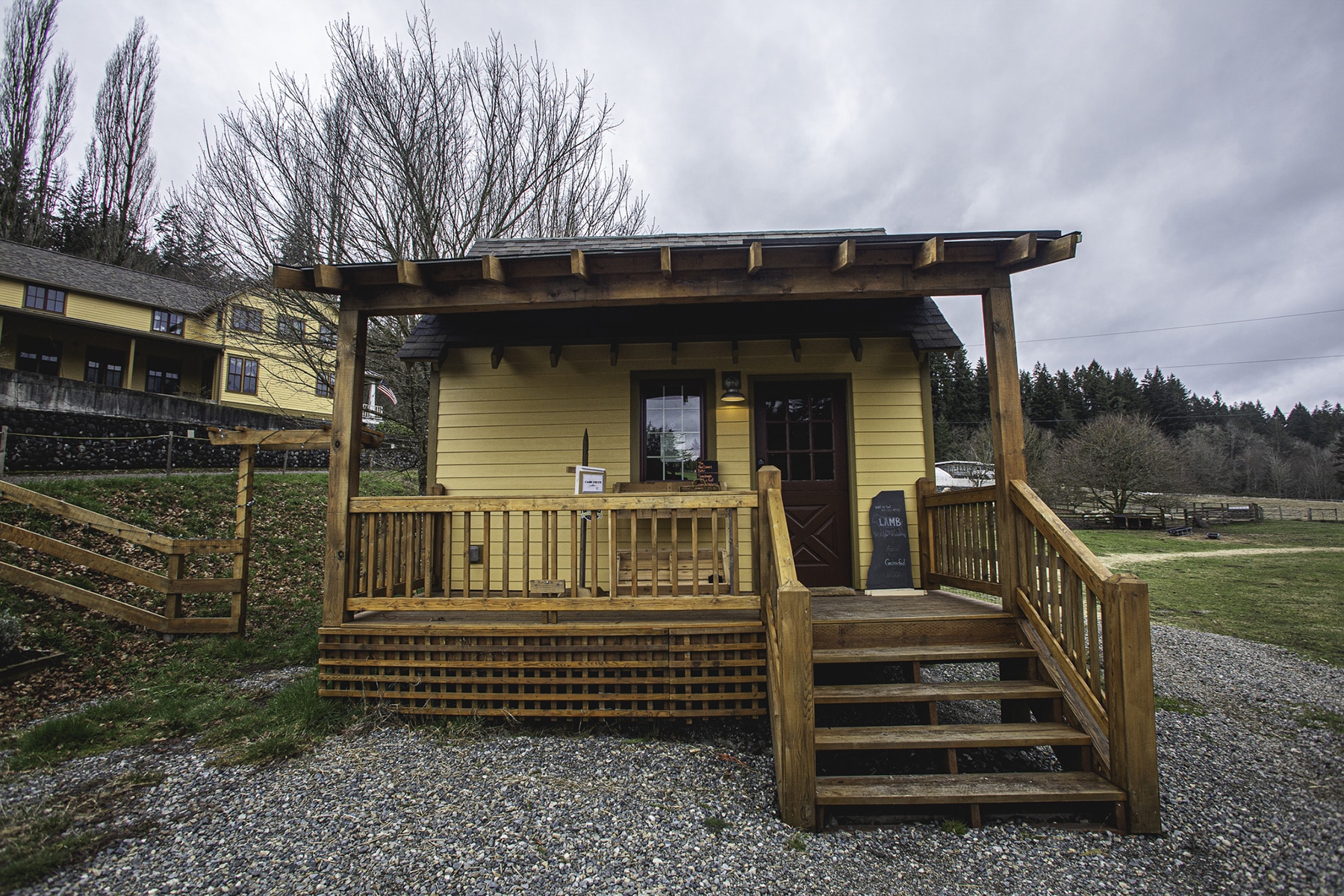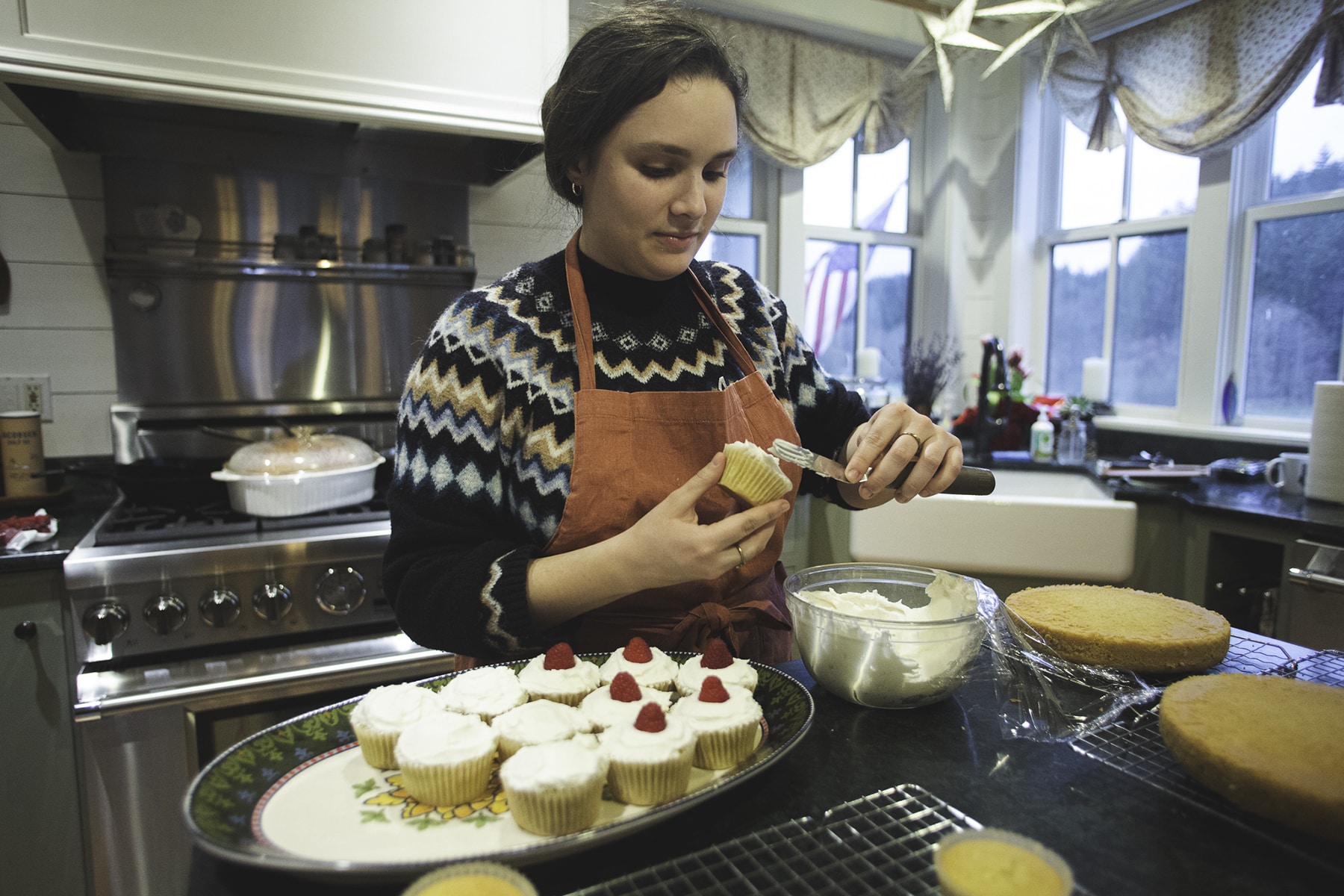Business Community Environment
Agritourism a growing concern for Gig Harbor farms
When Aileen Amico and her husband, Dennis, bought Blu Rooster Farm in 2016, she said, “all we had was a dog.”
After living in Gig Harbor for a decade, they were drawn to the farmhouse on 12 acres with sweeping territorial views of scenic rural Ray Nash valley. It was a place where their “kids could run.”
“It’s a pretty quaint piece of property,” said Aileen.
Today, the Amico’s microfarm offers U.S. Department of Agriculture-processed and packaged grass-fed pastured lamb; wool and pelts; organic chicken feed; and fresh chicken and seasonal duck eggs at their farm stand. Blu Rooster Farm also sells its lamb at Island View Market and the Arletta store.

Aileen Amico walks among her herd of sheep at Blu Rooster Farm on Ray Nash Drive in rural Gig Harbor.
Agritourism
In addition to all that, Blu Rooster Farm offers a variety of seasonal experiences that fall under the heading of agritourism. For instance, the farm hosted a Christmas Carol Sing-Along during the holiday season. In the fall, customers pick up pumpkins and gourds at the farm stand.
Agritourism is an important area of income growth and community connection for small farms. The USDA defines the practice as “a form of commercial enterprise that links agricultural production and/or processing with tourism to attract visitors onto a farm, ranch, or other agricultural business for the purposes of entertaining or educating the visitors while generating income for the farm, ranch, or business owner.”
Examples of agritourism include farm stands, shops, tours, u-pick, pumpkin patches, and wine tastings. One published study estimates that the global agritourism market could hit more than $11 billion by 2027.
Agritourism discussion
The Pierce County Council and the Pierce County Agriculture Advisory Committee will host a panel discussion on agritourism from 6:30 to 8 p.m. Wednesday, Feb. 22, at the Allmendinger Center in Puyallup. Topics include land use, zoning, permitting, county codes, promotions, advertising, liability, and more. Click here for a flyer, agenda and more information.
AgriTourism benefits both farms and tourists.
According to the WSU Cooperative Extension, “farm-based recreation activities have a widespread impact on economic and community development. They benefit not only farmers but also providers of other goods and services in the community.”
While agriculture is the second-leading export sector in the state, declining farm profits and real farm incomes over the past decade have put pressure on some farmers to utilize agritourism to augment their income.
That’s certainly true locally, including at Blu Rooster, where the farm stand will open officially following lambing season.
Blu Rooster
The farm has come a long way from its beginnings with just one dog and zero farming experience.
More than 20 goats, many with egg-shaped pregnant bodies, graze in a gently sloping pasture next to the barn. Two herding dogs are off duty inside the farmhouse, while a chorus of 130 clucking chickens fills the air.

The red barn at Blu Rooster Farm.
Two rams stand guard along the front fence adjacent to Ray Nash Road, uninterested in anyone but themselves and the February fields they’re eating for lunch. Tucked away from winter predators are two bunnies, a miniature lop and a lion head.
The farmer firsts are distant memories — the time the bald eagle ate one of their chickens; the emergency c-section in the barn for a breached lamb; the many spring birthday parties interrupted for the birth of lambs; and how was it that their son Seth had an uncanny ability to know just what to do during high-stakes lamb deliveries.
After several years of working (and continuing to work) their land (and their outside jobs), the Amicos plan to eventually apply for agriculture status, a tedious and carefully planned effort years in the making. Agriculture programs support farmers as they navigate the permitting procedures, interpret Pierce County regulations, and work with partners to access greater markets.
Now Blu Rooster’s farm stand offers a wide variety of goods. They include locally farmed mushrooms, raw milk from Port Orchard, and baked goods from daughter Mekenzie’s popular baking business, The Fives Loaves Baker.
Butler’s Farm
Gig Harbor has a rich history of farming dating back to the late 1800s. The fertile soil and mild climate made the Peninsula an ideal location for farming. Many families in the area established small, family-run farms that provided food for the local community.
Donna Butler has seen much of that history in the almost 50 years she and her husband have lived near the corner of 137th Street and Peacock Hill Avenue.
That’s where they now operate Butler’s Farm, a 7.5-acre orchard with 1,200 fruit trees and flowers.
When she first moved onto the property in 1974, she lived in a 13-foot trailer with an outdoor toilet. The only running water was in the bathtub. Eventually, they built a log cabin, but the construction process was slow.
They would buy “one piece of sheet rock per month,” she said. They “lived in the house as we built it.”
Donna is passionate about the farm. “We do it because we love it. People get to see the earth. You don’t see that anymore.”
In the 1950s and ’60s, she said, “every yard had 3 to 7 fruit trees, and you didn’t go to the grocery store to get fruit.” You simply picked the fruit from your own tree.

The new farm stand building at Blu Rooster Farm.
Farms and serving the community
She recognizes the important role their farm plays in educating the public about the life cycle of food, informing the community about where food comes from, and when locally grown produce is harvested in the Pacific Northwest.
For the past four years, Donna has been retired from her profession as a school teacher. She acknowledges that most small farmers cannot survive farming alone. An outside income is essential.
As a retiree, Donna is thrilled to put her full attention on activities that she loves, like farming. However, she feels the rising costs impact small farmers like her. “We pay more in taxes than our original mortgage,” said Butler.
Like so many farmers, Donna’s passion to serve her community keeps her looking to the upcoming season. Her farm stand will once again offer apples, along with figs, different seasonal fruits like raspberries, blueberries, pears, and even two persimmons this year. Butler’s Farm will also sell U-Cut dahlias. She expects her farm stand to get going by the end of July.
A vision for Ray Nash Valley
Aileen and Dennis Amico have a farmer’s dream. They would like to “return this (Ray Nash) Valley to an agriculture valley.”
Most people don’t use the farmland for farming, says Aileen. Her inspiration is Chimacum Valley in Jefferson County.
The idea is that area neighbors would take interest in contributing farm products and/or food; perhaps several farm stands along the valley route.
At one time, the land that now makes up Blu Rooster Farm was part of a 100-acre farm that covered much of the valley. Perhaps the community could collectively participate in agriculture tourism.
As the farm-to-table movement continues and vital farmland is lost, agritourism may find its stride in Pierce County and around the country.
On a recent trip to England, Aileen and Dennis Amico visited a large sheep farm with a flock of more than 800. After their trip abroad, they came home inspired to expand their business by providing a “farm stay” accommodation, similar to what they saw on the English sheep farm. A perfect “rural bolthole”, or glamping with a countryside view, may be on the horizon in the beautiful Ray Nash Valley at Blu Rooster Farm.

Mekenzie Amico operates a microbakery, The Five Loaves Baker, from her parents’ Blu Rooster Farm.

